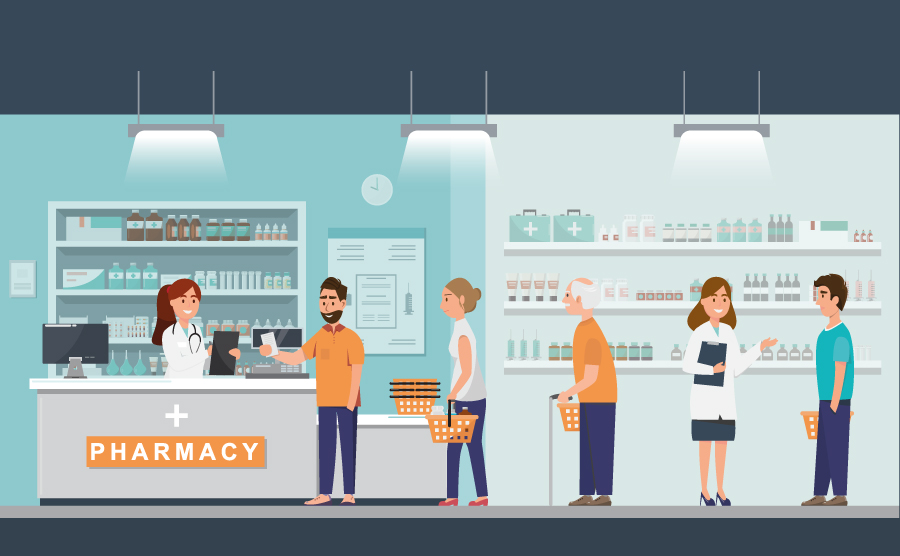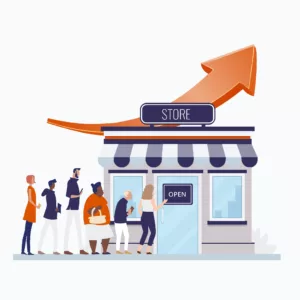Just four years ago, we discussed the pharmaceutical ecosystem’s transformation and the complexity of the economic environment in which it was taking place. Although the evolution is undeniable, structural restrictions are still present, and specific difficulties are more evident.
72% of the activity of pharmacies is still dependent on the highly regulated market for the delivery of refundable drugs. As prices continue to fall and dispensing fees are insufficient to cover the loss of revenue, the profitability challenges are even more significant today as the sector’s transformation continues. In this respect, growth drivers continue to revolve around diversifying the offer, implementing new services, and renewing the business, which is more firmly rooted in the healthcare system. The counterpart is a strong mobilization of time, human resources, training, and equipment, with the risk of exploding operating costs … even though the sector struggles to recruit all positions. The economic situation has reached a level of pressure (inflation, supply delays, active ingredient shortages, energy crisis) rarely equaled.
An Olympic-level challenge.
Between the sale of protective equipment and antigenic self-administered tests, screening, and vaccinations, the health crisis linked to Covid 19 has boosted pharmacies’ sales, experiencing two years of exceptional growth. In addition, physical and digital services have accelerated, with the pharmacist becoming a key player in the healthcare system.
However, this unprecedented crisis has also highlighted and even accentuated the widening gap in the trajectory of pharmacies. Since they do not start on an equal footing regarding their size and location, the rapid transformations have only benefited a small proportion of them. The ecosystem’s digitalization and the advent of electronic prescriptions could further widen the gaps. Moreover, as the profession is not attracting licensees, the pharmacy landscape is evolving towards a logic of concentration to benefit megastructures and to the disadvantage of small urban outlets and those in rural areas, which are closing rapidly.
How do you embrace such a contrast?
It’s now up to pharmacists to roll up their sleeves and make the most out of the available resources to set up an organization capable of :
- sustaining new activities despite the increased workload
- capitalize on the business fundamentals: expertise, customer knowledge, trust, and proximity
- ensure that the daily management of pharmacies is optimized as profitable hubs
- securing the business model
- to make each process profitable while preserving the quality of advice, service, and patient satisfaction.
Timeskipper’s industry update and recommendations for transforming your pharmacy while maintaining its performance.
TO REMEMBER
Revenues mainly depend on refundable drug prescriptions, despite changes in dispensing fees and the ROSP to limit the loss of margins.
Two key growth drivers to meet new healthcare needs:
- diversify the offer, facilitated by the membership of a pharmaceutical group
- increase services, particularly in the field of prevention
A non-negotiable condition: structure and enhance the transfer of new skills to the pharmacist to anchor their role in each stage of the patient’s overall health care journey.
Unequal abilities to adapt: the transition makes the smallest pharmacies more vulnerable, given their payment methods, fixed costs, and available space.
The pharmacy landscape is centralizing, and the pharmacy is evolving into a multi-role health hub.
Digitization and the advent of electronic prescription: the first step towards market deregulation?
Hence the need to adapt to pharmacies’ organizations to support the current transformations and ensure profitability.
Pharmacy revenues: guidance, dependence, and restrictions
The refundable drug market still represents nearly three-quarters of pharmacy activity.
Little has changed over the past four years. The refundable drugs segment alone accounts for 72.3% of pharmacy sales (6.9% for non-refundable drugs). This share varies slightly depending on the classification but is almost entirely subject to the volume of medical prescriptions. This activity is, therefore, highly conditioned, especially since public authorities strictly control manufacturers’ prices, margins, and promotional practices. As a result, pharmacies’ margins continue to deteriorate due to falling prices.
Indeed, with the health crisis in mind, drug refunds, and fees have jumped by 7.2% per year (compared to 3.8% excluding Covid expenses) between 2019 and 2021. And despite the expected slowdown in pandemic-related spending, forecasts for refundable drug sales show an increase of 0.1% in 2022, to €20.7 billion. It should be noted that the “arrival” of expensive products from the hospital circuit, which represent 18.7% of the market in value for a small volume of sales, and the growing weight of anti-cancer drugs contribute in part to this.
However, this exponential growth will be short-lived for some people in any case: on the expenditure side of Social Security, it’s time for austerity. Indeed, a saving of 640 million euros on refundable drugs and 150 million euros on medical devices was announced at the end of 2020 for 2021. And each new bill related to health insurance financing, such as, regarding radiologists buying their contrast products directly, is an additional cut for the traditional economic model.
Changes in dispensing fees and ROSP: limiting the loss of margins
Faced with the refundable drugs sector’s lack of flexibility, pharmacists have benefited from dispensing fees for several years. This payment method is applied automatically per prescription (1.02€ TTC to 2.76€ TTC), per box of medication (0.31€ TTC) with additional fees depending on the patient’s age (less than three years old or more than 70 years old) and the type of prescription (complex prescription, refundable product, specific product, etc.). Similarly, the ROSP (Funds on Public Health Objectives) allows pharmacies to be paid once a year based on criteria related to the quality of service and practice, a sustainable and optimized model, and the pharmacy’s modernization. In 2020, for 2019, the average ROSP of a committed pharmacy amounted to €9,462.60, of which more than 50% came from generic substitution.
Is this change in how pharmacies are paid sufficient to fight the decline in gross margins and decouple pharmacy performance from drug dispensing? The future seems uncertain.
While it’s clear that activity-based margin reforms must continue in favor of these fees, pharmacies must constantly find new growth drivers and ways to be profitable, whether or not they fall within the Convention’s scope. In this respect, diversification and the introduction of services in line with market developments and health, in general, must continue … this also raises the fundamental question of the pharmacist’s role in the health system.
What can pharmacies do in a system according to new health expectations?
Expanded product offerings across the entire healthcare market for increased value
Currently, 20% of pharmacies’ turnover comes from the trade of unregulated products pharmaceutical and veterinary products, advice, and medical equipment). In this respect, pharmacies, which are true retail outlets for health, prevention, well-being, and beauty, directly compete with specialized stores (Para pharmacies, perfume shops, cosmetics chains, and medical and orthopedic article distributors) and supermarkets. Moreover, we can see that the “self-service” model is gaining ground, occupying most large pharmacies’ sale areas.
So how do you stand out?
On the one hand, offering competitive prices is crucial, especially in urban areas where catchment areas can overlap. In this respect, many pharmacists join a grouping: as their bargaining power with suppliers is more significant, offering low prices without ruining margins becomes more accessible. It should also be noted that the rise of private label and optical products represents the latest alternatives for growth, especially for pharmacies that partner with Aprium, Elsie Santé, Pharmabest, Boticinal, etc.
On the other hand, these markets face a significant challenge regarding support. This is where the pharmacist can make all the difference, as they have the expertise, proximity, knowledge, and customers trust them. This fundamental foundation makes the pharmacy’s and the pharmacist’s role in the healthcare system legitimate.
That’s why we’re now talking about Pharmacy Doctors!
Services and Prevention: anchoring the pharmacist’s role at the heart of the health journey
Let’s face it, between the screenings and vaccination campaigns since spring 2021, the mobilization and efficiency demonstrated by pharmacies during Covid 19 have shown that the sector can renew itself quickly, as long as the demand is high, and the emergency leaves no other choice!
We certainly do not dispute the fact that the scope of TROD (Rapid Diagnostic Tests), protocol interviews for ALD (Long Term Conditions), or vaccination had already been expanded … But we must admit that this crisis has primarily highlighted the need for a transfer of skills … which goes well beyond the pandemic.
Indeed, new issues such as the aging of the population, the increase in chronic diseases, and the rise of medical deserts are changing patients’ expectations and needs. New healthcare practices are also developing around prevention, compliance, and services. This is where the pharmacist’s role as a pivotal point in the overall healthcare journey takes on its full importance.
Thus, since March 2022, the pharmaceutical agreement has endorsed the attribution and funding of additional skills to pharmacists in terms of prevention (kits for colorectal cancer screening), support (pregnant women), and access to care (management of acute cystitis, possibility of prescribing vaccine boosters, etc.).
Now, it’s a matter of reinforcing the pharmacist’s role at the heart of the patient’s care journey, considering current health issues. This challenge requires better structuring and enhancing the value of the tasks assigned to pharmacists and integrating them into every stage of patient care. Therefore, inter-professional proximity must be established between various health professionals, hospitals, and the pharmacist as the central pivot, thus enabling a gradual shift from a curative system to a preventive approach.
However, the task is impossible without lifting the risk of competition (article n°23 of the National Council of the Order of Physicians) and modifying the public health and probably the social security codes.
The reality of the transformation: disparate strengths and a marked restructuring of the pharmacy landscape
Small pharmacies and structures in rural areas: a fragile transition
8.3% of pharmacies have closed in 11 years, at a rate of between 180 and 230 per year, and the frequency continues to increase. In 2020, 44.7% of cases were immediate closure and the return of ARS licenses, 28.3% transferred their clients to a colleague, and 17% partnered with a larger structure. This phenomenon is primarily linked to the sluggish market, which weakens the margins of small pharmacies. We’re talking about tiny town pharmacies and establishments in rural areas – and potentially in a future medical desert – which nevertheless represents the enormous added value in territorial public health. In this respect, 60% of closures in 2020 will concern pharmacies with fewer than 1 million euros in turnover.
Added to this reality is the profession’s lack of attractiveness. There is a 30% shortage of students in the second year of pharmacy, despite the increase in students over the last 20 years. On the other hand, out of the 50,000 open positions for pharmacists and pharmacy assistants, 15,000 are vacant. Knowing that more than a quarter of the pharmacists will retire next year, we can say that the succession is far from assured, and the territorial network is in danger!
Unequal capacities of pharmacies to adapt to the health crisis and a more demanding global transformation
During the health crisis, pharmacies could implement screening and immunization services that came out on top, subject to other funding methods. These are pharmacies with annual sales of more than 2 million. They have repaid the additional labor costs of strengthening and training their teams. As a result, personnel costs (despite successive index point increases for pharmacy employees) and external expenses have been relatively well contained. In the end, these pharmacies recorded sales increases of 4.1% in 2020 and 7% in 2021, even managing to preserve their profitability with an increase in their EBITDA (Gross Operating Profit) rate from 8.3% to 8.6% between 2020 and 2021!
But Covid 19 has also added further pressure “right where it hurts the most.” This does not benefit everyone and has probably even accelerated the fall of some pharmacies, especially the smallest ones, which depend more on the sale of medicine. High fixed costs (rent and personnel costs), few recruitment possibilities, and a reduced space took much work to organize screening and vaccination. Also, establishments that turnover less than 2 million euros had to “make do” with selling protective equipment. Despite the introduction of home dispensing, these pharmacies will only show an increase of 1.1% and 1.5% in 2020 and 2021, meaning they couldn’t counterbalance the loss of their margins.
And with the announcement of new prices in 2023, it’s hard to imagine a positive outcome!
(Re)grouping and rebranding to absorb the transformation to a pharmacy of services.
We can see that the sector is getting stronger with a growing number of memberships to pharmaceutical groups, the largest of which, Objectif Pharma (La Coopérative Welcoop), has nearly 4,000 pharmacies. Beyond the promise of growth and better financial health, the network “sells” benefits in line with the sector’s transformation: mass purchasing, cost optimization, support services, and digital tools,…
Moreover, the rise of new-generation pharmacies, which represent 7% of the pharmacy network and 25% of the business volume, reinforces the need to have significant levers at one’s disposal to achieve transformation:
– benefit from a large surface area to carry out the necessary developments, on the one hand, for the deployment of new services and, on the other, for diversifying the offer
-a downtown location
– the transition to a brand name such as Elsie Santé and Aprium Pharmacie helps the company stand out in a competitive environment.
Through groupings and brands, these new “service pharmacies” models can implement prevention and patient support beyond the sole missions remunerated by health insurance, such as chronic pathologies (diabetes), acute care, or oncology. And it’s technological and organizational tools that can enable the logic of global respect.
Digitization: an evolution towards the pharmacy as a health hub
Assisted e-consultation and remote care.
Although still marginal not long ago, virtual consultations are becoming increasingly familiar with anti-Covid protection devices. Today, it’s increasingly common for a patient to be assisted by his pharmacist during a remote consultation with his doctor. As such, in 2021, Giphar, through a partnership with the start-up Medadom, has equipped 1350 pharmacies with connected terminals (with thermometers, blood pressure meters, …) for remote consultation.
Similarly, remote care consists of the patient talking to their pharmacist through videoconference and benefiting from the same services as if they had been in person: advice on treatment, a follow-up interview on a pathology, prescription renewal, and medical referral in the event of trauma.
The pharmaceutical group and the transition under a brand name: the digital acceleration
Larger groups still score points with pharmacists with the digitalization of pharmacies offering them a digital package, most often consisting of tools such as a website or social networks adapted to the sector.
But this is only the tip of the iceberg. We’re witnessing a strengthening of logistical (warehouses), financial (installation aids), and technological (back-office platforms) resources in the sector.
The objective? To ensure the performance of “new pharmacy logics” linked to the extension and industrialization of innovative services: omnichannel delivery (Click and Collect and Home Delivery), phygital services deployed around the various health missions, digital merchandising (touch terminals), access to DATA with the DMP and digital prescriptions, etc.
To support this transformation, which will include process automation and A.I. in the very near future, consolidation is a force that is becoming essential.
Electronic prescriptions: the revolution is now!
Tested on a small scale in 2019 and tested by only 259 doctors and 59 pharmacists in 8 departments at the end of 2022, electronic prescriptions will become widespread in the spring of 2023. The principle is simple: prescriptions made by healthcare professionals will be secured by a QR code and added to their patient’s Shared Medical Record (DMP), renamed “My Health Space,” in 2022. The doctor will coordinate information, dialogue, assessment, and treatment monitoring between several healthcare professionals, with the pharmacist guaranteeing the safety and proper use of medicines, whether prescribed or not. This is a real asset in an aging population to prevent iatrogenic risks in elderly people with multiple medications or under chronic treatment.
Still, medical professionals and pharmacists are yet to be convinced, educated in the practices, and, above all, equipped! In this respect, we’ll need to work twice as hard, as the deadline for having Segur software compatible with “My Health Space” and the electronic prescription system is March 15, 2023. At the end of 2022, only 2% of the documents added to “Mon Espace Santé” were issued by doctors, and in three years, only 50,000 electronic prescriptions out of the one million prescribed have been allotted.
Despite all the good intentions conveyed by this new device, the forceful emergences of e-prescriptions raise the question of the profession’s possible überization. In 2020, a bill to relax the conditions for opening online platforms dedicated to selling non-prescription drugs almost passed. Still, it was ultimately rejected … market deregulation and the beginning of the capital of pharmacies to non-pharmacists were too threatening. For now, the French pharmacy escapes third parties such as Amazon Pharmacy 22, which has been selling prescription drugs in the United States for two years and has recently become the home delivery platform for small and medium-sized Japanese pharmacies. Will French regulation resist the call of opportunity for much longer?
Until we reach that point, pharmacies are evolving into a true health hub closer to the consumer’s expectations and needs. But this carries organization-related consequences.
Impacts on pharmacy organization and customer experience improvement.
More comprehensive product ranges, new ways of working, additional services and missions, due to increased digitalization and potential understaffing … the entire organizational model is impacted, with employee activity on the front line. These changes imply a broadening of their skills and know-how and a substantial increase in the workload within a pharmacy whose surface area will have been reorganized in the best cases.
So how do you go about effectively reorganizing work within the pharmacy?
First, it’s crucial to identify each activity (reception, sales advice, dispensing prescriptions, interviews, medical procedures, support, orders preparation, deliveries, etc.) and measure each task’s workload.
It’s also essential to understand checkout times to dedicate specific queues and open the number of checkouts accordingly. Self-service products represent only half of the time spent at the checkout for advice products and one-third for prescription products. As for Click and Collect items, their processing differs from collecting a medical prescription or a sale following product advice.
Therefore, improvisation has no place, and working hours must be optimized. Prioritize and plan tasks, anticipate customer and product flow to allocate the right people (i.e., qualified and trained) to the different activities, at the right time, in the right place, for the proper time, and considering the flow of customers.
Despite the very tense economic context and the structural difficulties linked to the profession, pharmacy has solid assets: network capillarity, better-valued missions, a job that is more recognized about its “medical function,” a high level of knowledge and trust among patients, and for the time being, a pharmacy monopoly guaranteed by the health authorities. To succeed in the profitable transformation challenge, it’s vital to capitalize on these pillars by integrating the new market needs for services, prevention, and support… while keeping sight of the patient’s health! This transformation also implies a powerful managerial concept regarding work organization, and fostering team loyalty will be critical to adapt and perpetuating this model.
Timeskipper is the first SaaS platform for business management, specializing in issues related to the distribution business. In the context of complex changes in the pharmacy sector, the tool integrates the industry’s particularities, the company, and the point of sale to create an organization capable of absorbing these changes. The workload is measured at every stage according to field data, allowing resources to be allocated automatically according to the needs of the pharmacy’s activity. Thus, each working hour is valuable, and margins are maintained! With an ROI within less than six months, activity management makes pharmacies profitable again!






